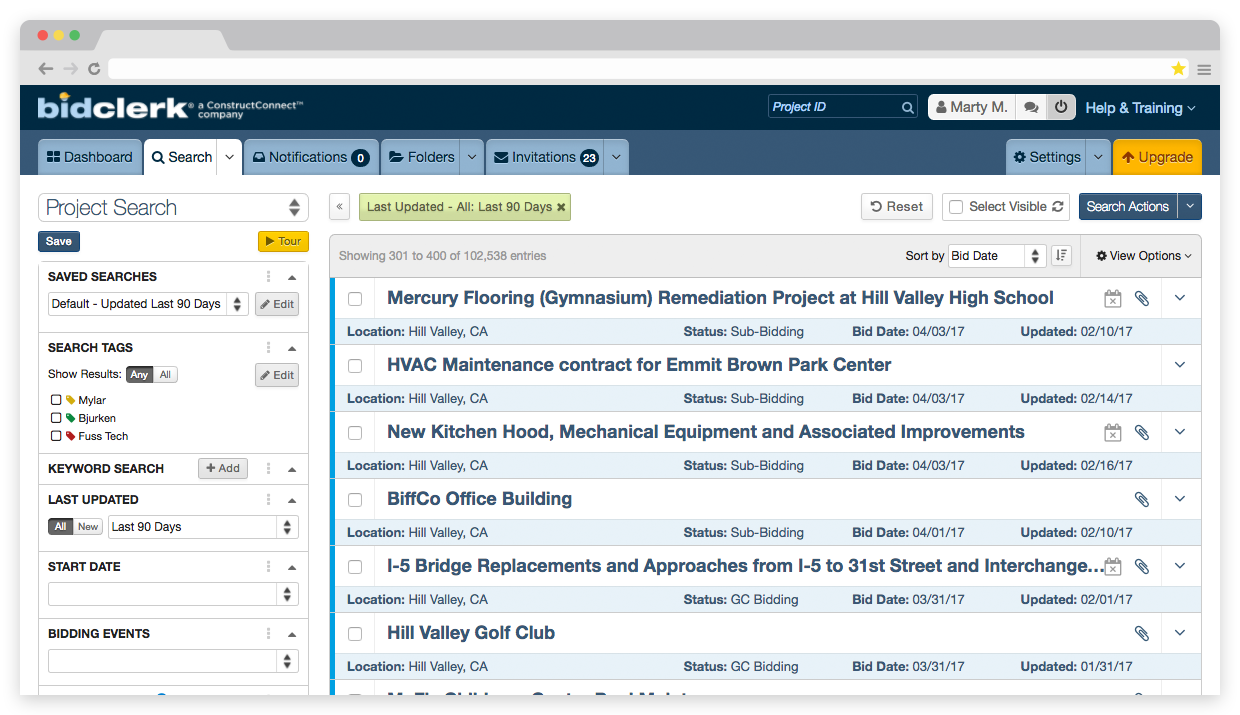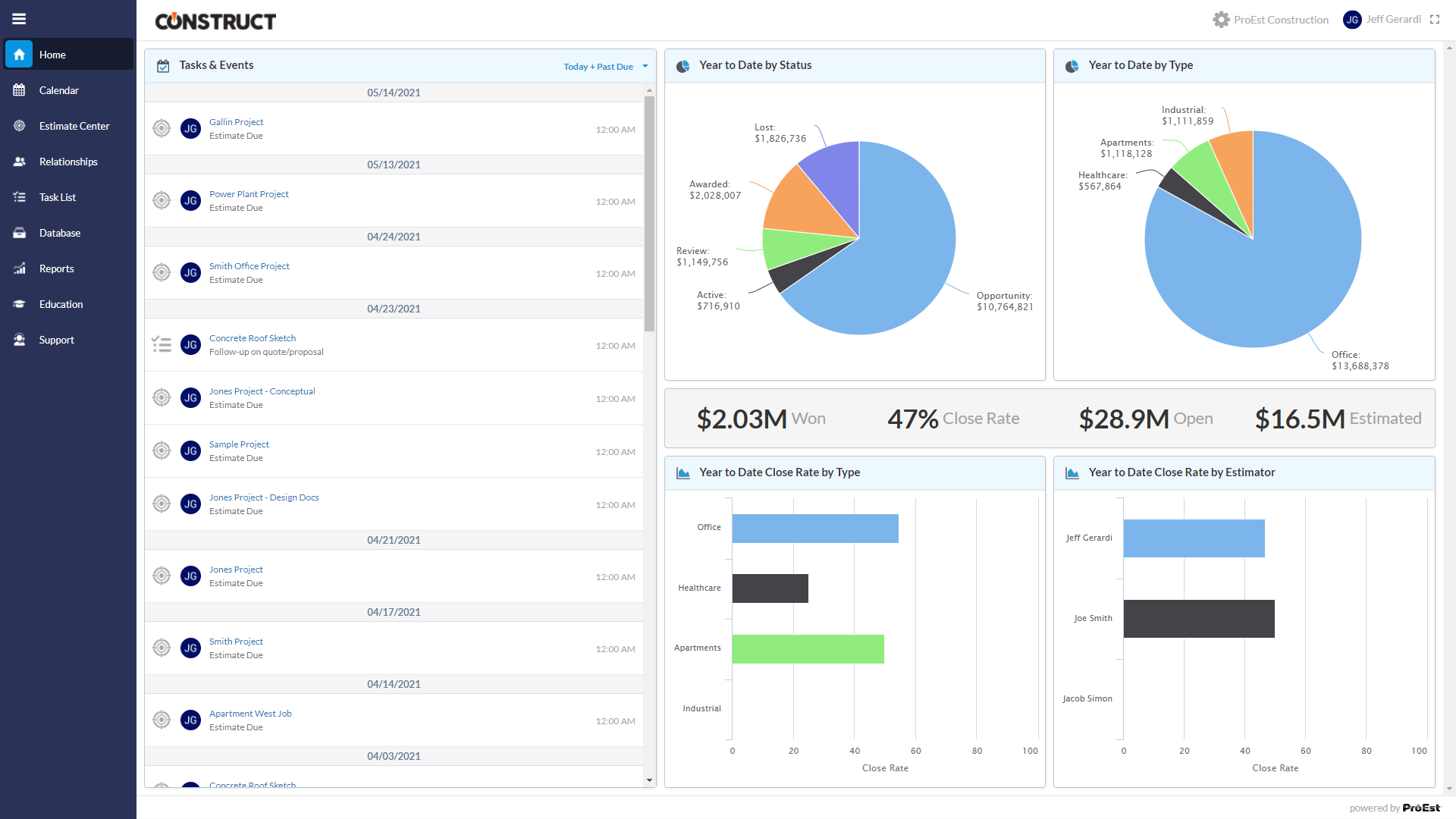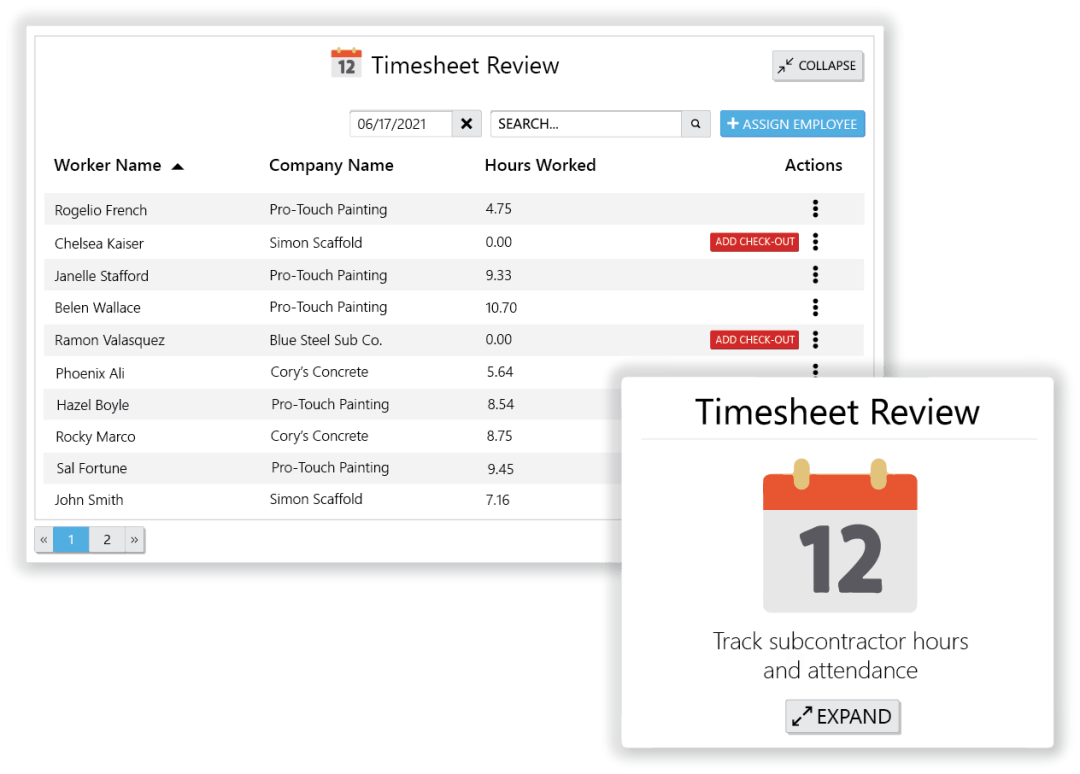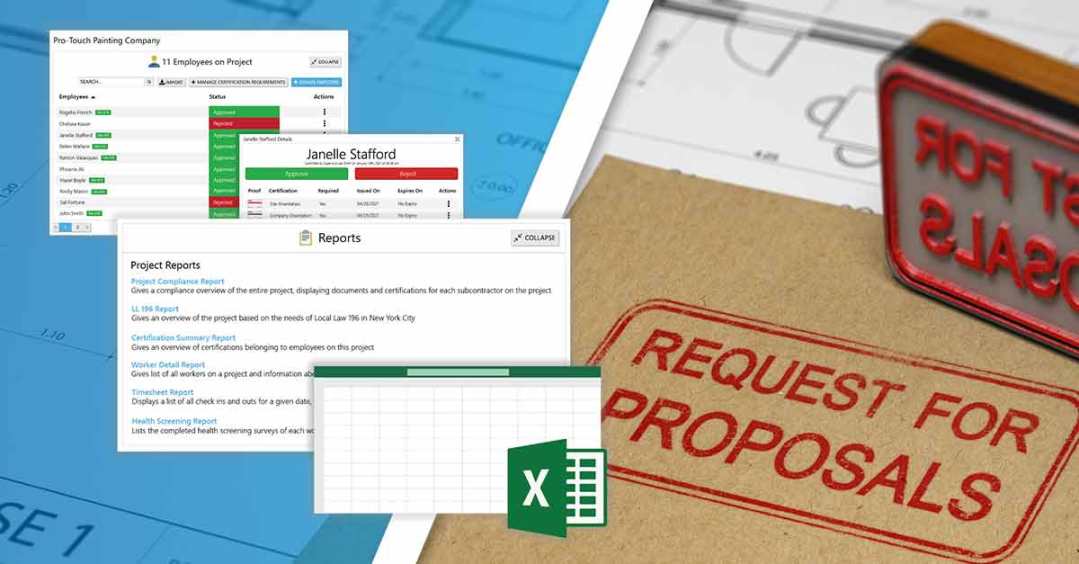Are you a general contractor (GC) or construction manager (CM) shopping for new projects? If so, then you are no stranger to the (often) tall task that is completing construction bids. If you are like the 40% of construction companies that lack confidence in the accuracy of their construction bids, then this article is for you.
Read on to get the low-down on construction bids and unlock six tips to help you improve your bids and maximize your bid-hit rate.
Table of Contents
Construction Bids 101
The Construction Bidding Process
Construction Contract Types
How to Win More Construction Bids (6 Steps)
1. Strategically Bid on Projects
2. Complete Your Construction Bids Early
3. Highlight Relevant Qualifications
4. Use Estimating Software
5. Showcase Productivity Enhancing Construction Technology
6. Showcase Key Demographic Data
Using myComply to Enhance Your Construction Bid Appeal
Construction Bids 101
Construction bids occur at two levels:
- The general contractor bidding on a project, as posted by the project/asset owner
- A subtrade/subcontractor bidding on project work, being managed by a GC
For a GC, construction bidding can be described as the process of organizing formal documentation for a potential client (the owner) to outline how your company would manage the construction of a given project.
For a subcontractor, construction bidding can be defined (similarly) as the process of providing a formal estimate for a specific scope of work within a broader construction project. However, this article will emphasize the construction bidding process from the lens of the GC, not the subcontractor
Now, let’s explore the construction bidding process for general contractors and the three most common construction contract types.
The Construction Bidding Process
Though the construction bidding tendering process can vary from owner-to-owner, the general workflow is as follows:
- Bid solicitation. This is the stage whereby the owner compiles a package of materials (including blueprints, specs, and other documents) to outline the scope of work that will be entailed by a project. Bid solicitation is also known as making a request for proposal (RFP) or a request to tender (RTT).
- Subcontractor bidding. Depending on the project method, GCs may be required to include subcontracting quotes as a component of their construction bids. If this is the case, then GCs must solicit their own bids for the work required to complete the project.
- Bid submission. Completed construction bids are submitted to the project owner.
- Bid selection. The owner reviews all submitted documentation and selects a winning GC for their project.
- Contract formation. This is the legal component of the construction bidding process, where final terms and conditions are drafted.
- Project delivery. The winning GC commences work on the project and aims to adhere by the delivery schedule outlined in their bid.
Once you understand the construction bidding process, it is time to take a deeper dive into the contract types that are most frequented in construction.
Construction Contract Types
A construction contract is the formal documentation, through which the project owner and the GC, construction manager (CM), or other managing entity agree to a set of terms, by which the project work must abide.
Different projects, of different scale, in various locations, belonging to different owners, tend to have different contract styles for production. A major factor in contract type is the project owner’s tolerance for risk, as some contract styles create greater opportunity for the owner to turn a profit, while others place the bulk of accountability on the GC or CM.
Here are the top three most frequented construction contract types:
- Fixed-price contract. In this contract style, the managing contractor agrees to a specific scope of work for a specific price. This is one of the most common contract styles and is the most risk averse option available to project owners. That being said, most of these contracts include some language that offers reward for the increased risk being embraced by the GC. These contract types also tend to include additional rewards for early project completion.
- Cost-plus contract. Cost-plus is a bit riskier of an option for project owners, as they agree (based on the quoted work) to pay for the entirety of project expenses, plus a specified margin (generally a percentage or fixed volume) for the GC. These contract types tend to also have a guaranteed maximum, acting as a bit of a safety net for the owner, while ensuring accountability from the GC.
- Time and materials contract. Though this contract type is much less common in the market for mega projects, it is frequently used for those with much smaller scopes of work. Under this model, the contractor simply bills the owner for labor and materials used. Without a ceiling in-place, this can be risky for the owner, so most of these contract types include a “not to exceed” clause, which means that the contractor must gain additional approvals from the owner if costs reach a certain threshold. In these instances, time and attendance systems can be a great way to closely monitor subcontractor hours.
How to Win More Construction Bids (6 Steps)
Winning construction bids and winning the “right” construction bids can be the difference between massive project margins or the razor thin margins (1.5-2%) the construction sector knows all too well. Worse yet? Many GCs have a low win-rate on construction bids.
Here are the average win-rates for general contractors across different construction sectors:
- Public works = 10% – 17%
- Private bids = 17% – 25%
- Negotiated work = 25% – 50%
- Design-build jobs = 25% – 50%
Source: 1st Source Bank
If your company specializes in public sector projects and is enjoying a bid-hit rate of roughly 10%, then you may be seriously overinvesting in bidding activities and may be missing the best projects for your team.
This section explores six tactics that contractors should leverage to improve their construction bids and capture more of the right business.
1. Strategically Bid on Projects
As a GC, if you want to succeed on the projects that you do take-on, then it is important that you do not bid on every project available within your market. Focus on higher quality bids for fewer projects.
Here are a few tips for determining which projects are a best fit for your company:
- Bid on jobs within your niche. If your specialty is high-rise builds in busy urban centers, then it might not make sense to enter a bid on a large-scale campus project in a remote setting.
- Shop for repeat business. Always consider the owner’s existing portfolio when entering a bid and look at upcoming work that they may be managing. It is much easier to retain business from a trusted partner than it is to gain new business from a new client.
- Play to your strengths. If a construction bid includes specializations that are not in your wheelhouse, then do not bid. Expanding the breadth of your services can be valuable, but it can also lead to lost margin due to strained execution.
2. Complete Your Construction Bids Early
The early bird gets the worm, right? The old adage holds some truth with respect to construction bids. This effect is also known as the “anchoring bias” or the “first impression bias,” and leads people to jump to conclusions based solely on what early learnings – as these influence all opinions after.
One of the most effective ways to get a jump on the top construction tenders in your market is to leverage some of the top bidding marketplaces.
The top three bidding marketplaces for GCs are:
- This massive database has over 400,000 project tenders added every year. This platform allows users to easily search projects by location, and project posting requirements are detailed, which allows GCs to cut down on the research process and make informed construction bids. If you’re a GC in North America, then BidClerk is a must.

Source: BidClerk
- Whether you are looking for pre-bid projects, public sector jobs, or private ownership project opportunities, BidCentral has you covered. Also take advantage of intelligent tools like opportunity matching and automated notifications for best-fit projects.
- This prominent construction bidding platform is home to over 800,000 professionals and allows users to shop projects by several filters, including: location, sector, project value, project type, and stories.
3. Highlight Relevant Qualifications
Just like applying for a job, a grant, an award, or anything else with a formal application process, you always need to ask yourself “why am I the best-fit for X?” Once you have clarified the answer to that, then you need to relay that through your proposal.
The best way to highlight qualifications in a construction bid is to:
- Showcase experience. Do you have testimonials from satisfied customers on similar projects? Or case studies showing your performance? Include these are supporting bid documentation so that the prospective owner knows the value that you offer.
- Position your team as experts. Where other bids might simply be competing on price-point, positioning your team as subject matter experts for the specific scope of work presented in the tender, you stand to promote greater trust – a key driver in the selection process.
4. Use Estimating Software
Though the best price does not necessarily win the bid, an accurate project estimate not only helps your construction bid appeal, but it also protects you from the repercussions of underbidding. This is a major issue for most contractors in the construction space. In fact, a recent study by QuickBooks and TSheets found that 40% of respondents lack confidence in their bid estimates and a third of all construction companies fail to meet the profit targets outlined in their construction bids.
Construction managers and general contractors can’t afford to be unconfident in their bids. That’s why estimating software is essential, especially for mega projects.
Here are some of the top construction estimating software solutions for GCs:
- Esticom. This cloud-based construction estimating software helps general/specialty contractors to eliminate paper plans and Excel spreadsheets from their estimating process, which generally results in 3x the bidding capacity. Using Procore for project management? Esticom is a Procore company so integrate these solutions with ease.
- STACK. One of the leading preconstruction technology solutions on the market. Not only can GCs benefit from intelligent estimating and proposal building tools, but they also get access to document management tools for designs, and a cloud-based material takeoff solution.
- ProEst. GCs need a project pipeline, and your cost estimators are responsible for delivering that. Using historical data, ProEst helps contractors to nail their bids, but also keep their projects on schedule throughout the entire delivery process.

Source: ProEst
5. Showcase Productivity Enhancing Construction Technology
When general contractors approach the bidding process, they should not only think about construction technologies that enhance the preconstruction process, but also technologies that will improve their day-to-day operations on the project. A productive workforce is a profitable workforce.
By increasing worker productivity, a GC is making their labor investment go further, which means reduced costs per task completion and the ability to deliver projects faster. These are two VERY appealing items to include in your construction bids.
Here are some of the top productivity enhancing solutions for construction:
- PlanGrid. A tool that helps GCs to track the progress of their projects, improves collaboration, and reduces rework by aggregating all issues in one place and allowing administrators to make real-time adjustments to project plans. This serves to dramatically reduce the need for rework-related activities.
- myComply. An integrated compliance solution that gives GCs the ability to manage every single worker on their sites, track their qualifications, flag workers that do not meet site requirements, and track time and attendance data down to the minute.

Source: myComply
- Autodesk BIM 360. If you are a GC that specializes in mega projects, then a building information modeling (BIM) system is a must. This sophisticated project solution allows general contractors to connect all workflows, teams, and all the data that runs throughout to improve quality, reduce risk, and keep projects on schedule.
6. Showcase Key Demographic Data
Though demographic reporting is not required by any state authority, there are some opportunities in presenting and documenting diversity in your construction bids.
Here is why you should consider reporting workforce demographics in your construction bids:
- The American Rescue Plan Act of 2021. The most recent COVID-19 relief package includes billions of dollars for capital projects, but much of this project-based funding will be based on those projects that meet certain standards with respect to rural population density, lower-income regions, and demonstrated diversity. That means that general contractors with diverse teams may have a leg-up when bidding to owners that are looking to secure governmental support for their capital projects.
- Minority & Diversity Certification Programs. Many states have minority and gender-geared programs that are intended to help diverse companies acquire business (ex. the City of New York Minority and Women-Owned Business Enterprises (M/WBE) Program). Though these programs don’t do anything to directly improve bid-appeal, they may open communication channels with valuable project owners in your region.
Learn more: Construction Workforce Demographics: Why You Need to Report Them
Using myComply to Enhance Your Construction Bid Appeal
Formulating construction bids can be a complex and arduous task. The tactics outlined in this article will help general contractors to enhance their bid appeal, but only with the right teams and technologies in-place.
myComply is one of the best tools available to general contractors that are looking to generate more data from their projects so that they can create more informed bids on future projects.
Here is why you should consider using myComply on your next project:
- Deep project data. myComply’s Projects Pro platform unlocks otherwise inaccessible data for general contractors and construction managers. For example, general contractors can see every worker on each of their projects in real-time, they can see all their time and attendance data, down to the minute, they can access demographic data, and they can download on-demand reports to support each of these categories.
- Productivity enhancement. An accountable workforce is a productive workforce. myComply eliminates the labour inflation that is all too common in the construction sector by eliminating timesheets and creating live/automated timeclocks.
- Enhanced site safety. myComply’s certification tracking functionality allows general contractors to set certification requirements for every worker at every subcontractor. This means that only workers that meet your qualifications will be allowed on-site. This eliminates the risk of unqualified workers conducting work on your projects and protects you from the risk of non-compliance related fines.
- Lower insurance costs. myComply helps to promote a lower EMR rating, which has a direct impact on your insurance costs in both a traditional or wrap-up insurance Furthermore, global insurance entities, like Hartford and AXA XL, have recognized the use of myComply by contractors on projects as a technology that reduces risk. Reduce risk with myComply, lower EMR, and use the insurance savings to present a more price-competitive bid.
Book a demo or request a starter kit today to begin your journey towards improved construction bids and a fully optimized workforce.



